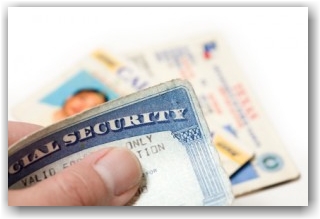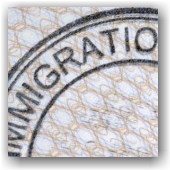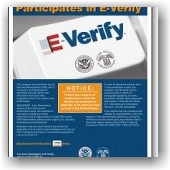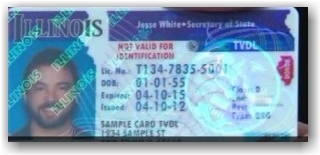Archive for the ‘I-9/E-Verify News’ Category
Friday, July 17th, 2015

USCIS released details of proposed new changes to the E-Verify program on June 8, 2015 that were published this week. The notice, found here, proposes several changes to E-Verify and seeks public comments until August 7, 2015 and links to new Q&A. These changes will affect all employer users, including Federal Acquisition Regulation (FAR) contractors.
The three critical changes entail:
1) Requirement that employers re-verify the continuing work authorization of employees within three “Employer” days of the expiration of the employee’s “last” grant of work authorization.
a) This requirement tracks the current continuing duty of employers to re-verify expiring work authorization of employees in Section 3 of the I-9 form or, in the alternative, to complete a new I-9.
b) This differs from the I-9 process in that the E-Verify time frame for re-verification of the employment authorization is three days after its expiration, whereby the I-9 regulations state that an employer re-verify the expiring work authorization of an employee on or before the day it expires. In E-Verify, the proposed process cannot be started until after the expiration of the employment authorization.
c) The re-verification requirement extends to employees hired before an employer began participating in the E-Verify program. Thus, the proposed change would require that employers re-verify an employee’s expiring work authorization regardless of whether they have previously created an E-Verify case for that employee or not. This again differs from the current E-Verify program rules that explicitly prohibit an employer verifying the work authorization of employees hired before the employer began participating in the program (with the exception of FAR E-Verify employers).
2) Requirement that employers print the re-verification confirmation page and retain it along with an employee’s I-9 records or record the E-Verify re-verification case number on the employee’s I-9 Form.
3) Provides a process for employees to seek review of E-Verify Final-Nonconfirmations.
::::::::
Immigration Compliance Group provides US inbound visa services to individuals and employers throughout the USA and abroad. We specialize in business immigration and have a depth of experience in the IT, healthcare, arts, entertainment and sports industries, amongst others. Our services include complex business visas for investors, multinational managers, skilled professionals, outstanding individuals of high achievement and PERM Labor Certification. We additionally provide employer compliance consulting services on proper I-9 (Employment Eligibility Verification) management, auditing, training, and work with our clients to develop a culture of immigration compliance.
Tags: Agriculture, E-Verify, Employer Compliance, FAR E-Verify, Federal Contractors, I-9 Compliance, I-9 Form, I-9/E-Verify News, ICE, Immigration News, Legal Workforce, OSC, Seasonal Workers, USCIS
Posted in Agriculture, Employer Compliance, Federal Contractors, I-9/E-Verify News, ICE, Immigration News, OSC, USCIS | Comments Off on E-Verify Announces Major Proposed Changes
Saturday, June 20th, 2015
 Since early 2015, qualified California residents have been able to apply for and receive a driver’s license issued by the Department of Motor Vehicles without proving that their presence in the United States is authorized under federal law. All employers must accept the AB 60 driver’s license as a Form I-9 List B Identity document if the license reasonably appears to be genuine and to relate to the individual. As with all permissible List B driver’s licenses, the AB 60 driver’s license must contain either a photograph or list the individual’s name, date of birth, gender, height, eye color, and address. The AB 60 driver’s license only documents the employee’s identity; California employers must still examine a List C document that establishes employment authorization, such as a Social Security card or birth certificate.
Since early 2015, qualified California residents have been able to apply for and receive a driver’s license issued by the Department of Motor Vehicles without proving that their presence in the United States is authorized under federal law. All employers must accept the AB 60 driver’s license as a Form I-9 List B Identity document if the license reasonably appears to be genuine and to relate to the individual. As with all permissible List B driver’s licenses, the AB 60 driver’s license must contain either a photograph or list the individual’s name, date of birth, gender, height, eye color, and address. The AB 60 driver’s license only documents the employee’s identity; California employers must still examine a List C document that establishes employment authorization, such as a Social Security card or birth certificate.
View the Example of the AB-CA Driver’s License annotated with “Federal Benefits Apply”.
Tags: CA AB-60 Driver's License, DACA, Department Of Homeland Security (DHS), Employer Compliance, EMPLOYMENT ELIGIBILITY, I-9 Form, I-9/E-Verify News, ICE, Immigration News, Legal Workforce, OSC, Social Security, USCIS
Posted in DACA | DAPA, Employer Compliance, I-9/E-Verify News, ICE, Immigration Legislation, Immigration News, OSC, Social Security, USCIS | Comments Off on California New AB 60 Driver’s License: Is it Good for Employment Eligibility?
Sunday, December 7th, 2014

On November 20, 2014, President Obama announced efforts to retool critical aspects of the immigration system—how we enforce immigration laws, how we process immigration benefits, how we encourage further business innovation, and how we welcome immigrants to this nation.
Following the address, executive agencies made available intra-agency memoranda and fact sheets detailing specific actions that have already been taken, or will be taken in the future in ten areas within the confines of the law. These actions generally involve border security, the current unlawfully present population, or future legal immigration.
Below we link to Fact Sheets that address the details that we are aware of at this time of the 10 Executive Action Initiatives with links to the memoranda. Additional guidance will be forthcoming.
The expansion of the DACA program that has now removed the age restriction and increases employment authorization from 2 year to 3-year increments, is expected to go into effect on or about February 20, 2015. The implementation of DAPA, the Deferred Action for Parental Accountability, that allows parents of US citizens and lawful permanent residents who have been present in the country since January 1, 2010 to request deferred action and employment authorization, is expected to roll out approximately mid-May 2015.
Resources:
http://www.uscis.gov/immigrationaction
http://www.dhs.gov/immigration-action
http://www.immigrationpolicy.org/special-reports/guide-immigration-accountability-executive-action
Should you have questions at this time or would like to retain our office to assist you or your employees with their immigration matters, please contact us at info@immigrationcompliancegroup.com or call 562 612.3996.
Tags: Business Innovation, DACA, DAPA, Department Of Homeland Security (DHS), Executive Action, H-1B, H-4, I-9 Form, ICE, Immigration News, Immigration Reform, Investor Visas, Undocumented Workers, USCIS
Posted in Comprehensive Immigration Reform, Congress, DACA | DAPA, Department Of Homeland Security (DHS), Employer Compliance, H-1B Visas, I-9/E-Verify News, ICE, Immigration News | Comments Off on Executive Actions on Immigration
Tuesday, October 7th, 2014

IMPORTANT INFORMATION
As of January 1, 2015, E-Verify will begin disposing of E-Verify records that are over 10 years old. In order to retain case information, E-Verify employers may download and save the new “Historic Records Report.” If you want a record of your cases that are more than 10 years old, you must download the new Historic Records Report before December 31, 2014. The report will include all transaction records for cases more than 10 years old. The report is only available until December 31, 2014.
NOTE – this Report will ONLY BE AVAILABLE from October 1, through December 31, 2014. The Fact Sheet provides more information as to how to proceed to download applicable E-Verify records.
If you were not using E-Verify on or before December 31, 2004, you do not need to download the report. There will be no records to report. Note that E-Verify will continue this practice on an annual basis.
:::::::::::::::::::::::::::::::::::::::::::::
USCIS Now Offering I-9 Webinars On-Demand
On September 25, 2014, USCIS published the first Form I-9 Webinar On – Demand. Now you can watch the free Form I-9 webinar at any time.
Choose the chapters of your choice or watch the entire 22 minute video in one sitting. You will see how to complete Sections 1, 2 and 3, best practices
and much more. It’s a great training tool. Visit I-9 Central to learn more and view other videos in the multi-media section.
 Form I-9 Webinar on Demand | USCIS uscis.gov
Form I-9 Webinar on Demand | USCIS uscis.gov
Tags: E-Verify, E-Verify Records Retention, Employer Compliance Policy, form I-9, I-9 On-Demand Webinars, I-9/E-Verify News, ICE, Immigration News, OSC, USCIS
Posted in Employer Compliance, I-9/E-Verify News, ICE, Immigration News, OSC, USCIS | Comments Off on E-Verify Records Retention and Disposal | I-9 Webinars On-Demand
Wednesday, February 12th, 2014

Last October, CA was the 10th state to sign into law driver’s “permits” for undocumented immigrants. In response to an email concerning this topic and whether this would be an acceptable List B document for I-9 purposes, the OSC posted a Technical Assistance letter response a few days ago on its website.
It has been my understanding that the permits will contain language that states that they are not to be used for “federal official purposes,” and will contain a notice on the card that reads: “This license is issued only as a license to drive a motor vehicle. It does not establish eligibility for employment, voter registration, or public benefits. ”
The matter, however, is timely addressed and is a reminder to examine driver’s licenses more closely and read the fine print on the front and back. Here’s a link to the letter that was posted on Feb. 7th. You’ll see it posted under the heading “Fiscal Year 2014.”
Also, here’s an article with an example of the card being used in Illinois stating “not valid for identification” indicated very clearly at the top of the card.
If any of our readers more recently have run across one of these cards presented during the I-9 process, please share with us.
Tags: CA passes law to issue Driver's Licenses to Undocumented, DACA, Deferred Action, DMV, Driver's License for Undocumented, I-9 Employment Eligibility, I-9/E-Verify News, Immigration News, Legal Workforce, List B Document
Posted in Comprehensive Immigration Reform, Employer Compliance, I-9/E-Verify News, Immigration Legislation, OSC, USCIS | Comments Off on Will Driver’s Licenses for the Undocumented be Acceptable for I-9 Purposes?
Sunday, January 5th, 2014
 DHS/ICE continues to issue Notices of Intent to Fine (NOFs) at an unprecedented rate for Form I-9 related infractions. Mistakes occur in the I-9 process, it’s inevitable. While establishing a written compliance policy, training and careful prevention is the best approach. All employers should take time at the beginning of each year to conduct an internal audit and self-examination of their systems, operating procedures, and past and present practices for handling I-9s, as well as to access training needs for the employees charged with handling and supervising the I-9 process. We also recommend that you review your E-Verify submissions, as well as revisiting just how compliant your I-9 software really is with your vendor if you are using an electronic system.
DHS/ICE continues to issue Notices of Intent to Fine (NOFs) at an unprecedented rate for Form I-9 related infractions. Mistakes occur in the I-9 process, it’s inevitable. While establishing a written compliance policy, training and careful prevention is the best approach. All employers should take time at the beginning of each year to conduct an internal audit and self-examination of their systems, operating procedures, and past and present practices for handling I-9s, as well as to access training needs for the employees charged with handling and supervising the I-9 process. We also recommend that you review your E-Verify submissions, as well as revisiting just how compliant your I-9 software really is with your vendor if you are using an electronic system.
While there are many checklists and do-it-yourself guides and webinars available on the Internet and elsewhere, consulting a licensed attorney or specialist in the field who is familiar with I-9 and E-Verify compliance issues can save employers hours of research, provide a solution tailored to your organization, and save you thousands of dollars in fines and penalties should ICE knock on your door.
When ICE notifies an employer of their intention to perform an audit, it opens the door for an onslaught of inquiries and investigation from other government agencies that range from SSA mis-match issues to Department of Labor (DOL) wage and hour, USCIS, IRS, and more if you have areas of incompliance in your operating procedures. This is not the time during an audit when under pressure to clean up compliance problems.
New employers are often more at risk because many are not even aware of the I-9 requirement, and probably are also unaware of the need for all employees to complete the I-9 Form. Some are aware, but they lack knowledge concerning the regulations that govern the form; such as, timeframes, acceptable documents, form retention, and other important details that are integral to the process. Particularly, there are problems with industries such as IT consulting, healthcare, staffing agencies, and other organizations with multiple locations in regard to completing the I-9-Form remotely with the employer’s designated agent and employee in different locations.
These are just a few reasons why we urge you to assess the strengths and weaknesses of your present compliance program, and start the New Year fresh with a renewed commitment to implement best practices that will provide the foundation upon which you can develop and maintain a more compliant business and workforce.
You might be interested in joining our LinkedIn group, I-9/E-Verify: Smart Solutions for Employers,” and signing up to receive via RSS feed or email our Blog posts.
Tags: +, Department Of Homeland Security (DHS), DOL, E-Verify, I-9 AUDIT, I-9 Best Practices, I-9 Comipliance, I-9 Form, I-9 Training, I-9/E-Verify News, ICE, Immigration News, Legal Workforce, OSC, SSA
Posted in Department Of Homeland Security (DHS), Department Of Labor (DOL), Employer Compliance, Healthcare, I-9/E-Verify News, ICE, Immigration News, OSC, Social Security, Staffing Agencies, USCIS | Comments Off on Compliance Audits are Recommended for Employers at the Beginning of the New Year
Friday, November 29th, 2013
 On December 8, 2013 E-Verify will release new and revised Memorandums of Understanding (MOUs) that are tailored to each access method.
On December 8, 2013 E-Verify will release new and revised Memorandums of Understanding (MOUs) that are tailored to each access method.
The changes were made in response to customer feedback and to update the MOUs with policy and process changes. Users will find that the new versions have more plain language and are easier to understand, with new titles that clearly identify the access method to which the MOU applies, and bullets that have been changed to letters and numbers to make searching and citation easier. Also, the lengthy sections have been broken up.
Please take the time to review and become familiar with the new MOU’s that apply to your access method; refer to the Fact Sheet and the preview of the new MOUs here. You can also access this information under “View Essential Resources” by logging into E-Verify to review the new and revised MOUs.
What you need to know
- Current E-Verify users will not be required to execute a new MOU, but are bound by any and all enhancements to the E-Verify program including the new or revised MOUs that apply to their access method. Current users should become familiar with the new or revised MOU that applies to them. The effective date of the MOU for existing users is January 8, 2014.
- The E-Verify enrollment process has not changed. New Users will review and execute the new or revised version of the MOU that applies to their access method during enrollment. The effective date of the MOU for new users is December 8, 2013.
- The new and revised MOUs include several updated provisions such as enhanced privacy protections and instructions for reporting privacy and security breaches.
Revised Memorandums of Understanding
TeleConferences
Two teleconferences will be hosted by USCIS to introduce and discuss the revisions schedule as follows:
1) For General Audience: December 11(Wed.) 2:30 – 3:30 EST. Will discuss the revisions made to the existing MOU’s and will open up for Questions. Register here
2) For E-Verify Users: December 12 (Thurs.), 2:30 – 3:30 EST. USCIS officials will provide an overview of the three new MOUs for Web service participants, and be available to answer questions. Register here
If you have any questions regarding the registration process, or if you have not received confirmation email within two business days, please email us at Public.Engagement@uscis.dhs.gov.
Tags: Department Of Homeland Security (DHS), E-Verify, E-Verify MOU, Employment Eligibility Verification, I-9 Form, I-9/E-Verify News, I-9/E-Verify News, ICE, Immigration News, Legal Workforce, SSA, USCIS
Posted in Employer Compliance, I-9/E-Verify News, ICE, Immigration News, Social Security, USCIS | Comments Off on E-Verify Update —–New/Revised MOU’s Released
Monday, November 11th, 2013

While DHS/ICE continues to issue Notices of Intent to Fine (NOFs) at an unprecedented rate for Form I-9 related infractions, this is yet another reminder that you can choose to pay the fine or you can contest the fine and file for a hearing (within 30 days of receipt of the NOF) before an Administrative Law Judge (ALJ) who handles cases related to employer sanctions, document fraud and unfair immigration-related employment practices. OCAHO has more than proven that they are willing to reassess and lower fees in just about every case in recent months.
Note that many employer sanctions cases never proceed to the hearing stage because either the parties reach a settlement with the approval of the ALJ, or the ALJ resolves a case through a prehearing ruling.
We recommend that your first step in the process be to retain experienced representation that specializes in the practice area of employer compliance to guide you step by step through the process – don’t attempt to go this alone. The next step is to understand the process that has been summarized very efficiently in the recent Fact Sheet that we refer to here
Should you have any questions or wish to become a client of our office, please contact us or refer to our services & solutions page.
Tags: ALJ I-9 Hearing, Department Of Homeland Security (DHS), Document Fraud, DOL, Employer Sanctions, I-9 Fees, I-9 Form, I-9/E-Verify News, ICE Audit, ICE Investigation, Immigration News, IRCA, Legal Workforce, Notice of Intent to Fine, OCAHO, OSC, SSA
Posted in DOJ, Employer Compliance, Federal Contractors, I-9/E-Verify News, ICE, Immigration News, OSC, Social Security | Comments Off on How to Contest an I-9 Notice of Intent to Fine (NOF)
Thursday, October 31st, 2013

Infosys is India’s second largest software exporter, and has about 30,000 workers in the U.S. (160,000 worldwide) with $6B in sales.
After years of investigation, it was found that Infosys “knowingly and unlawfully” brought Indian workers into the United States on B-1 business visitor visas( since 2008), to circumvent the higher costs and delays of a longer-term employment-related visa, such as the H-1B visa that the workers should have had. It was found that Infosys systematically submitted misleading information to US immigration authorities and consular officials to obtain the B-1 visas that do not permit employment, unfairly gaining a competitive edge and undercutting American workers qualified for the jobs
Press release states: “Infosys failed to maintain I-9 records for many of its foreign nationals in the United States in 2010 and 2011 as required by law, including a widespread failure to update and re-verify the employment authorization status of a large percentage of its foreign national employees…more than 80 percent of Infosys’s I-9 forms for 2010 and 2011 contained substantive violations.”
The largest fine of its kind, was paid out as follows: $5 million to Homeland Security Investigations, $5 million to the Department of State, and $24 million to the DOJ.
How can employers protect themselves?
The five federal agencies charged with workplace enforcement are not only going after businesses that are known to employ undocumented workers, but they are also making examples out of industry leaders across the country creating headline news. It goes without saying, that this is now a topic that should be on HR executives’ action list. Turning a blind eye can be exceedingly costly and cause great damage to a company’s reputation.
For more on this Story: CBS Reports NY Times
For more on our services and solutions
Tags: B-1 Visa, Business Immigration, DOL, H-1B Visa, HSI, I-9 Violations, I-9/E-Verify News, ICE Audit, ICE Investigation, ICE NOI, Indian IT Industry, Infosys, Legal Workforce, Skilled Professionals, Specialty Workers, SSA, US Consulates, USCIS, Visa Fraud
Posted in Department Of Homeland Security (DHS), Department Of Labor (DOL), Department of State, Employer Compliance, H-1B Visas, I-9/E-Verify News, ICE, Immigration News, Social Security, USCIS | Comments Off on Infosys to pay $34M in Fines for Visa Fraud and I-9 Violations
Thursday, October 24th, 2013
 We have written many articles over the years on what happens when ICE serves an employer with a Notice of Inspection (NOI); see below for links to our articles and resources. Today, ICE released a new Fact Sheet that referrences the IRCA law in the 1st paragraph, and then summarizes the order in which an ICE administrative inspection proceeds, the types of notices that are issued following an I-9 ICE audit, how fines are determined based upon knowingly hiring and continuing to employ violations, to substantive and uncorrected techical violations, and how these fines and penalties are calculated.
We have written many articles over the years on what happens when ICE serves an employer with a Notice of Inspection (NOI); see below for links to our articles and resources. Today, ICE released a new Fact Sheet that referrences the IRCA law in the 1st paragraph, and then summarizes the order in which an ICE administrative inspection proceeds, the types of notices that are issued following an I-9 ICE audit, how fines are determined based upon knowingly hiring and continuing to employ violations, to substantive and uncorrected techical violations, and how these fines and penalties are calculated.
The penalties for ignoring the legal requirements of the I-9 process can be quite severe, even in cases of unintentional omissions and uncorrected I-9 mistakes. Civil penalties for such errors may range from $110 to $1,100 for each effected employee. A business with thousands of employees and multiple worksites may face a significant financial burden in noncompliance penalties. The fines may be further increased if ICE determines that an employer knowingly hired unauthorized foreign nationals, and can range from $375 to $16,000 per violation with repeat offenders on the high end. Employers and their representatives convicted of having engaged in a pattern or practice of knowingly hiring unauthorized foreign nationals, may also face criminal charges and fines of up to $3,000 per employee and/or six months’ imprisonment. Other federal criminal statues may provide higher penalties in certain fraud cases.
Employers and individuals who commit citizenship status or national origin discrimination may be ordered to pay civil fines and attorneys’ fees. The penalties range from $375 to $3,200 for the first offense for each individual discriminated against; from $3,200 to $6,500 for the second offense; and for subsequent offenses, not less than $4,300 and not more than $16,000 for each person effected.
The trend toward increased scrutiny of immigration employment practices will likely continue in the foreseeable future. With immigration reform still uncertain, ICE continues to step up enforcement activities with a deluge of NOI’s to employers every few months. These recent developments have made it even more critical that employers maintain a strong immigration compliance profile. Employers can no longer afford to think that because they don’t hire foreign nationals, they don’t have any I-9 issues or need to comply with I-9 immigration regulations.
The key to I-9 compliance for most organizations starts with a thorough self-examination of existing paper I-9’s, E-Verify submissions (if applicable), standard operating procedures, and past practices. While there are many checklists and do-it-yourself guides, free webinars and Podcasts available on the Internet and elsewhere, consulting an experienced immigration consultant or attorney in the practice area can save employers hours of research, provide a solution tailored to your organization and save you thousands of dollars in fines and penalties.
You should strongly consider an independent I-9 audit if…
- You’ve had a turnover in the HR position(s) charged with the responsibility of handling and processing I-9 Forms
- None of the staff charged with the I-9 process has been formally trained
- You already know that you have I-9 document violations, errors and unintentional mistakes
- You have recently gone through a corporate reorganization, merger or acquisition
- You know you have an on-boarding process that is complex, such as multiple jobsite locations where the I-9 process takes place
- When you haven’t documented your I-9 Form policies and procedures in a policy statement or procedures manual
- If you have a large volume of foreign worker I-9 forms
- If you do not have a calendar system for re-verification or terminated employee retention
- If you do not have a centralized I-9 recordkeeping process
- If you are photocopying documents presented during the I-9 process for some and not for others
- You participate in government contracts and have been asked to perform an I-9 audit
- You have not performed a random or full audit within the last year by either an internal individual who is familiar with I-9 compliance rules but does not deal with I-9s on a regular basis, or by a reputable independent I-9 auditor.
- You’ve never performed a self-audit or had any outside provider perform an I-9 audit
- You do not know how to make corrections to the I-9 form
- You’ve received SSA No Match Letters
- Your industry is being targeted by ICE
- You’re unaware that a new I-9 form was released and do not have a process in place for staying current with regulations and procedures
Immigration Compliance Group regularly represents clients from all industries to develop effective I-9 policies and compliance programs. By establishing and maintaining effective corporate policies and procedures, many of the above-mentioned warning signs can be addressed proactively in an audit before the government does one for you.
New ICE Fact Sheet
I-9Audit.com – Our Employer Resource Center Articles
Tags: Department Of Homeland Security (DHS), I-9 AUDIT, I-9 Compliance, I-9 News, I-9 Training, I-9/E-Verify, I-9/E-Verify News, ICE, ICE Audit, ICE Fines, ICE Inspection Fact Sheet, ICE Penalties, Immigration News, Legal Workforce, NOI, Notice of Inspection, OSC, SSA
Posted in Department Of Homeland Security (DHS), Employer Compliance, Federal Contractors, I-9/E-Verify News, ICE, Immigration News, OSC, Social Security | Comments Off on ICE Releases New Fact Sheet on the I-9 Inspection Process









